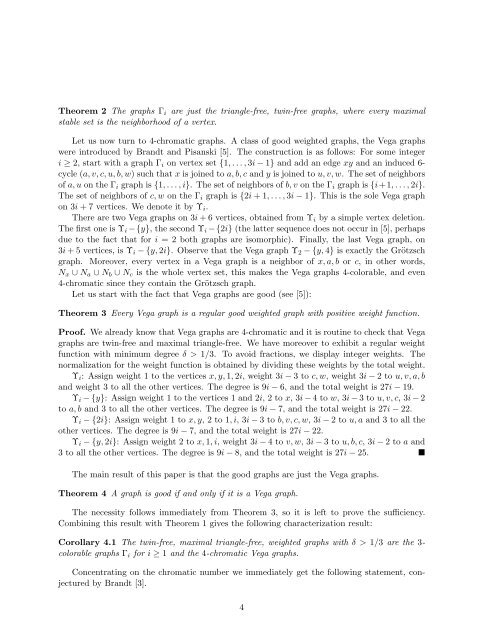Dense triangle-free graphs are four-colorable: A solution to ... - Lirmm
Dense triangle-free graphs are four-colorable: A solution to ... - Lirmm
Dense triangle-free graphs are four-colorable: A solution to ... - Lirmm
You also want an ePaper? Increase the reach of your titles
YUMPU automatically turns print PDFs into web optimized ePapers that Google loves.
Theorem 2 The <strong>graphs</strong> Γi <strong>are</strong> just the <strong>triangle</strong>-<strong>free</strong>, twin-<strong>free</strong> <strong>graphs</strong>, where every maximal<br />
stable set is the neighborhood of a vertex.<br />
Let us now turn <strong>to</strong> 4-chromatic <strong>graphs</strong>. A class of good weighted <strong>graphs</strong>, the Vega <strong>graphs</strong><br />
were introduced by Brandt and Pisanski [5]. The construction is as follows: For some integer<br />
i ≥ 2, start with a graph Γi on vertex set {1, . . . , 3i − 1} and add an edge xy and an induced 6cycle<br />
(a, v, c, u, b, w) such that x is joined <strong>to</strong> a, b, c and y is joined <strong>to</strong> u, v, w. The set of neighbors<br />
of a, u on the Γi graph is {1, . . . , i}. The set of neighbors of b, v on the Γi graph is {i+1, . . . , 2i}.<br />
The set of neighbors of c, w on the Γi graph is {2i + 1, . . . , 3i − 1}. This is the sole Vega graph<br />
on 3i + 7 vertices. We denote it by Υi.<br />
There <strong>are</strong> two Vega <strong>graphs</strong> on 3i + 6 vertices, obtained from Υi by a simple vertex deletion.<br />
The first one is Υi −{y}, the second Υi −{2i} (the latter sequence does not occur in [5], perhaps<br />
due <strong>to</strong> the fact that for i = 2 both <strong>graphs</strong> <strong>are</strong> isomorphic). Finally, the last Vega graph, on<br />
3i + 5 vertices, is Υi − {y, 2i}. Observe that the Vega graph Υ2 − {y, 4} is exactly the Grötzsch<br />
graph. Moreover, every vertex in a Vega graph is a neighbor of x, a, b or c, in other words,<br />
Nx ∪ Na ∪ Nb ∪ Nc is the whole vertex set, this makes the Vega <strong>graphs</strong> 4-<strong>colorable</strong>, and even<br />
4-chromatic since they contain the Grötzsch graph.<br />
Let us start with the fact that Vega <strong>graphs</strong> <strong>are</strong> good (see [5]):<br />
Theorem 3 Every Vega graph is a regular good weighted graph with positive weight function.<br />
Proof. We already know that Vega <strong>graphs</strong> <strong>are</strong> 4-chromatic and it is routine <strong>to</strong> check that Vega<br />
<strong>graphs</strong> <strong>are</strong> twin-<strong>free</strong> and maximal <strong>triangle</strong>-<strong>free</strong>. We have moreover <strong>to</strong> exhibit a regular weight<br />
function with minimum degree δ > 1/3. To avoid fractions, we display integer weights. The<br />
normalization for the weight function is obtained by dividing these weights by the <strong>to</strong>tal weight.<br />
Υi: Assign weight 1 <strong>to</strong> the vertices x, y, 1, 2i, weight 3i − 3 <strong>to</strong> c, w, weight 3i − 2 <strong>to</strong> u, v, a, b<br />
and weight 3 <strong>to</strong> all the other vertices. The degree is 9i − 6, and the <strong>to</strong>tal weight is 27i − 19.<br />
Υi − {y}: Assign weight 1 <strong>to</strong> the vertices 1 and 2i, 2 <strong>to</strong> x, 3i − 4 <strong>to</strong> w, 3i − 3 <strong>to</strong> u, v, c, 3i − 2<br />
<strong>to</strong> a, b and 3 <strong>to</strong> all the other vertices. The degree is 9i − 7, and the <strong>to</strong>tal weight is 27i − 22.<br />
Υi − {2i}: Assign weight 1 <strong>to</strong> x, y, 2 <strong>to</strong> 1, i, 3i − 3 <strong>to</strong> b, v, c, w, 3i − 2 <strong>to</strong> u, a and 3 <strong>to</strong> all the<br />
other vertices. The degree is 9i − 7, and the <strong>to</strong>tal weight is 27i − 22.<br />
Υi − {y, 2i}: Assign weight 2 <strong>to</strong> x, 1, i, weight 3i − 4 <strong>to</strong> v, w, 3i − 3 <strong>to</strong> u, b, c, 3i − 2 <strong>to</strong> a and<br />
3 <strong>to</strong> all the other vertices. The degree is 9i − 8, and the <strong>to</strong>tal weight is 27i − 25. <br />
The main result of this paper is that the good <strong>graphs</strong> <strong>are</strong> just the Vega <strong>graphs</strong>.<br />
Theorem 4 A graph is good if and only if it is a Vega graph.<br />
The necessity follows immediately from Theorem 3, so it is left <strong>to</strong> prove the sufficiency.<br />
Combining this result with Theorem 1 gives the following characterization result:<br />
Corollary 4.1 The twin-<strong>free</strong>, maximal <strong>triangle</strong>-<strong>free</strong>, weighted <strong>graphs</strong> with δ > 1/3 <strong>are</strong> the 3<strong>colorable</strong><br />
<strong>graphs</strong> Γi for i ≥ 1 and the 4-chromatic Vega <strong>graphs</strong>.<br />
Concentrating on the chromatic number we immediately get the following statement, conjectured<br />
by Brandt [3].<br />
4

















